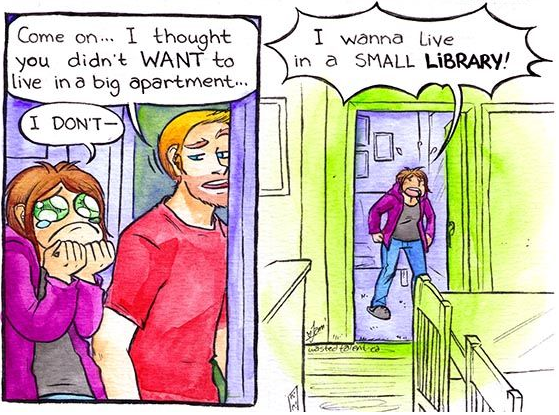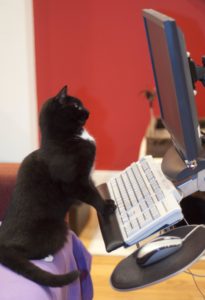
I still recall that a part of graduating from the education department at my undergrad institution included writing a strong philosophy of education. After all of the education classes, the analysis of education, the observations, the reflections, and my own student teaching, I still felt as though my educational philosophy was evolving and changing, so I was not completely happy with the outcome. True to life, my thoughts and feelings about education have grown as I’ve learned more and observed the ebb and flow of educational trends.
When I was asked to write a Statement of Professional Philosophy for my MLIS Plan B, I again felt shifting ideas brushing into each other as I considered what I should write. I finally decided to distill the three most important aspects of librarianship that I hope I have continually embodied even before obtaining my MLIS and that I hope to continue to embody as I move forward in my career.
Three values have cropped up over and over in my employment history: ensuring access to education, helping those who need assistance, and making information easy to access and understand. My undergraduate work was in English education with a minor in Spanish, and it was at my alma mater that I met Dr. Patricia Newcomer (AKA Doña Patricia) my first library mentor who also happened to be my advanced Spanish professor. When I graduated, Doña Patricia encouraged me to continue on and to obtain a Master’s Degree in Library and Information Science. I, in my less than infinite wisdom, instead chose to go immediately into the working world.
Doña Patricia passed away shortly after I graduated, so I am sad to say that she will never see her hopes for me come to fruition. However, it is clear that she and the other librarians at my college’s library, where I worked for four straight years, have had a profound effect on my mental view of and development into a librarian. Beyond all of the mundane, technical tasks that were completed in that library, the ideals of education and assistance as well as warmth and kindness were taught to me on a daily basis. Being a librarian and an information professional means being open, inviting, giving, and helpful. Why else would a person go into a professional that prides itself on service to all and includes diversity among its chief values and goals for growth?
In the preface of his forthcoming book, Dr. Michael Stephens (2016) wrote the following words, words that have the ring of authority and the air of truth about them:
For me, the heart of librarianship is learning. It’s a cyclical process of support, engagement, and discovery with deep roots in the concepts of service, access, and freedom to pursue interests of all kinds. No matter what type of institution, someone is gaining knowledge, finding information, or creating something new based on our facilitation. And in my opinion, the role of facilitator and guide is best delivered with humanity and heart.
Libraries encourage the heart, which means we should lead from the heart, learn from the heart, and play from the heart. It means we are all-in all the time, not just when it’s convenient. It means bucking the status quo to do the right thing at the right moment. It means owning our actions as professionals. It means creating institutions that expand minds and craft futures. (pp. xiii-xiv)
These words of Dr. Stephens show a spirit of openness that librarians need to remain true to the value of service that our professional prides itself on. I am currently working with Dr. Stephens on a special studies section this semester, and viewing his work and his ethic has helped further solidify my own feelings about several important characteristics that I feel an information professional should have.
Curiosity
How anyone could become a librarian without having an indefatigable sense of curiosity and an overwhelming urge to always be learning is incomprehensible to me. From the time I was a young child, I have been curious about how things work and how to help things work better. I am quite lucky that my parents allowed and cultivated this sense of curiosity by allowing me to take things apart, put things together, and read whatever I could get my hands on. Curiosity is one of the essential traits that all information professionals must have and must continue to cultivate throughout their lives.
We information professionals should be seeking curiosity in its many incarnations. Education never stops, and reading is an important part of this ongoing, adult education. Technology is changing at a rapid pace, and emerging technologies are coming along quickly. Asking ourselves questions and being able to find the answers quickly and efficiently will only allow us to learn more and to help others learn as well. If we aren’t curious and aren’t willing to ask questions and to seek the answers, how can we expect our patrons and users to do so?
When I was a Fall 2014 LIBR 203 Peer Mentor, I wrote a blog post titled “Curiosity and the Information Professional.” I still firmly believe everything I wrote in that post, including the following important points:
Dig in! Don’t be afraid! If you can’t figure something out, ask someone who might know or even Google it. As future information professionals, curiosity is our calling and finding out new and helpful information is our trademark.
Remember, curiosity didn’t really kill the cat. And even though what he was curious about just might have (it was probably a venomous snake or something), technology doesn’t have that power and won’t strike, so go ahead and seek more information and gather more data. Curiosity is knowledge-seeking, which isn’t such a bad trait in a librarian. (para. 11-12)
In fact, I would argue that it’s not just a good trait for information professionals: it’s essential.
Inclusivity
Diversity and inclusivity go hand in hand throughout the world, whether you are a library professional or not. That said, librarians are on the front lines of ensuring access to all, no matter a person’s socioeconomic status, race, religion, gender, and so on. Education and information are extremely important to ensure the growth of our profession and to help each person with her/his own personal educational goals.
I am disappointed to live in a country that does not prize learning a second language from childhood, because I feel that this is an important part of helping others feel included. I myself began learning Spanish in high school, minored in it for my undergraduate degree, and took the Advanced Spanish for Librarians course while at SJSU to help refresh my skills and to learn the library-specific language and jargon that I may need in a professional capacity. Although it is not possible to learn every language that we may find ourselves needing, learning even one additional language means that we can reach and help more people. In such a global society, it becomes even more important to open ourselves up to new experiences, different cultures, and differing ideas. F. Scott Fitzgerald (2005) once wrote (oddly enough, in the same essay in which he would also later describe some of his own prejudices) the following:
[L]et me make a general observation – the test of a first-rate intelligence is the ability to hold two opposed ideas in the mind at the same time, and still retain the ability to function. One should, for example, be able to see that things are hopeless and yet be determined to make them otherwise. (p. 139)
This seems to be a great description of what librarians should strive to do: maintain as many ideas, opposed or similar, as possible to help all who come seeking assistance without regard to any supposed differences. We are not called to believe all of the ideas or to hold any specific, but we are called to move beyond the mere idea of tolerance to a far greater respect and empathy for our fellow human being—to becoming advocates for the unheard and voiceless in our communities.
Empathy
Empathy requires each of us to gain the ability to put ourselves in someone else’s shoes, to move beyond our own feelings to hopefully better gauge what someone else is possibly feeling and thinking. Dialogue with others and self-reflection are key first steps on the road to empathy. “It has been shown that empathy plays a clear role in facilitating more effective communication between library staff and users, whether or not English is their first language” (Birdi, Wilson, & Tso, 2009, p. 87).
What do our patrons need and want from us? What are the needs of our surrounding community, and how can we fulfill those needs to the best of our ability? This can and will differ in each community: it will depend greatly on the makeup of your surrounding community and the needs of the people who use our facilities and services. I believe that this is a circle of knowledge that needs to be consistently monitored to ensure that the library is offering services that the community needs in order to fulfill and help plug any holes in community services that can be provided by the library.
Librarians are, without a doubt, ensconced within a helping profession. Altruism and a desire to meet people where they are coming from are essential requirements for a truly empathetic nature, so keeping current with social justice issues along with a knowledge of local community needs and issues is required to ensure our ability to meet those needs and to address those issues in our own communities.
References
Birdi, B., Wilson, K., & Tso, H.M (2009) The nature and role of empathy in public librarianship. Journal of Librarianship and Information Science, 41(2), pp. 81-89. http://dx.doi.org/10.1177/0961000609102827
Fitzgerald, F. S. (2005). My lost city: Personal essays, 1920-1940. Cambridge, UK: Cambridge University Press.
Stephens, M. (2016). The heart of librarianship: Attentive, positive, and purposeful change. Chicago, IL: ALA Editions.





